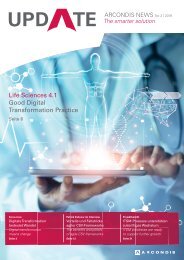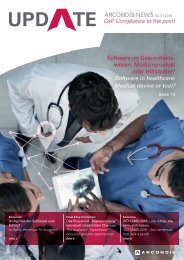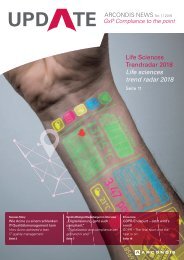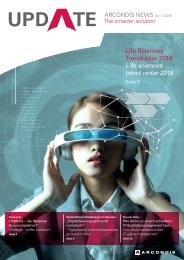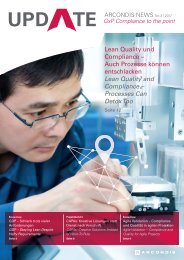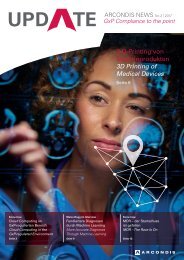ARCONDIS UPDATE No. 02|2018: The smarter solution
ARCONDIS Kundennewsletter für den Themenbereich Business Applications in Life Sciences Unternehmen
ARCONDIS Kundennewsletter für den Themenbereich Business Applications in Life Sciences Unternehmen
Sie wollen auch ein ePaper? Erhöhen Sie die Reichweite Ihrer Titel.
YUMPU macht aus Druck-PDFs automatisch weboptimierte ePaper, die Google liebt.
8_<strong>The</strong> <strong>smarter</strong> <strong>solution</strong> 9<br />
Es braucht ein funktionierendes Eco-System<br />
aus Life Sciences, Healthcare, Politik, Forschung<br />
und Lehre, die eng zusammenarbeiten.<br />
Dazu muss ein Portfolio an Digital Life<br />
Sciences Initiativen ausgearbeitet werden,<br />
welches über Innovationsprojekte angegangen<br />
wird. Ziel muss es sein, innovative<br />
Firmen, Start-ups und Konsortien zu fördern,<br />
eine Plattform zu schaffen, die Innovationsträger<br />
mit den richtigen Leuten in der<br />
Wirtschaft schnell zusammenbringt und die<br />
Einstiegshürden reduziert.<br />
Ein einzelnes Unternehmen wird die digitale<br />
Transformation eines Landes in der Branche<br />
nicht vorantreiben können. Neben unseren<br />
traditionellen Unternehmen, brauchen wir in<br />
Zukunft dringend auch Firmen mit datengetriebenen<br />
Geschäftsmodellen. Wir sollten<br />
gerade diesen Bereich fördern und entwickeln,<br />
um unseren Standort erfolgreich in die<br />
Zukunft zu führen. Dazu gehört:<br />
Schaffen einer Strategie „Digitale Transformation<br />
in Life Sciences“ mit Key-Playern<br />
Identifikation der notwendigen Schlüsselkompetenzen<br />
für die digitale Transformation<br />
Evaluation der heutigen Situation (SWOT)<br />
Definition und Finanzierung eines Marktplatzes/einer<br />
Plattform für Innovationsträger<br />
und Industrie<br />
Definition und Anstoss von Leuchtturm-<br />
Projekten für alle Kompetenzbereiche<br />
Stärkung der bereichsübergreifenden<br />
Zusammenarbeit und Mobilisierung aller<br />
Ressourcen<br />
Förderung vom dualen Bildungssystem<br />
für die Erarbeitung von neuen Berufsgruppen,<br />
die der Markt in der Zukunft braucht<br />
Vernetzung aller Interessensgruppen<br />
Forderung und Schaffung eines regulatorischen<br />
Umfelds, das die Innovationen<br />
unterstützt – wie die Automobilindustrie<br />
beim <strong>The</strong>ma autonomes Fahren beweist,<br />
kann die Entwicklung die Gesetzgebung<br />
formen<br />
Schaffung eines gesetzlichen Rahmens<br />
für den Austausch von anonymisierten<br />
medizinischen Daten (zur Sicherheit für<br />
alle Beteiligten und gegen Verunsicherung<br />
der Patienten)<br />
Die <strong>The</strong>matik und das Potenzial in der<br />
Life Sciences Branche wurde von einigen<br />
Unternehmungen bereits erkannt. Aber es<br />
sind noch zu wenige und es braucht einen<br />
breiteren und vor allen Dingen gemeinsamen<br />
Aufbruch, mindestens aber die<br />
Förderung von innovativen Start-ups. Denn<br />
es ist an der Zeit, mit den Vorreitern, wie<br />
beispielsweise Apple, Google, Amazon oder<br />
Microsoft, Schritt zu halten und die Möglichkeiten<br />
der Digitalen Transformation im Blick<br />
zu behalten. Das kann nicht Aufgabe nur<br />
weniger grosser Hersteller sein, sondern<br />
benötigt eine branchenweite Bewegung aus<br />
möglichst vielen kleinen, mittelständischen<br />
und grossen Unternehmen, um wieder an innovativere<br />
Branchen aufzuschliessen. Schon<br />
allein aus Eigennutz, um den Wettbewerbsvorsprung<br />
auszubauen. Marco Rogg<br />
Marco Rogg<br />
Senior Manager,<br />
<strong>ARCONDIS</strong><br />
English<br />
E_A wave of digitalization has been<br />
sweeping all industries. Media, banking,<br />
insurance, telecommunications and<br />
retail are pioneering this development.<br />
Under the banner of “Industry 4.0,” the<br />
digital structures are also taking over the<br />
processing industry at a rapid pace, with<br />
automotive clearly ahead of the game. An<br />
idea that started with streaming services<br />
for music has expanded to new payment<br />
methods, new services and whole new<br />
currencies. As a society, we have welcomed<br />
the digital transformation into<br />
our daily lives without much friction. But<br />
what about the life sciences? <strong>The</strong> clocks<br />
still seem to be ticking a bit too slow in<br />
our industry.<br />
Small startups are busy filling the gaps that<br />
larger players are neglecting. <strong>The</strong> Baltimore<br />
startup Insilico Medicine, for instance, is<br />
utilizing artificial intelligence extremely<br />
innovatively to develop new pharmaceuticals.<br />
Google and Amazon, the de-facto<br />
pioneers of digitalization, are well aware of<br />
the immense opportunities offered by the<br />
life sciences sector. <strong>The</strong>y are pouring their<br />
own strengths into the industry, and many of<br />
their services are already causing a stir.<br />
Why does our industry not live up to its full<br />
potential, leaving the field to newcomers and<br />
industry outsiders instead?<br />
Why the sector is lacking<br />
momentum<br />
<strong>No</strong>t all companies are stuck in the past.<br />
Campaigns by global leaders such as Roche<br />
and <strong>No</strong>vartis are well underway. <strong>The</strong>y focus<br />
on personalized medicine, digital patient<br />
engagement, studies on the efficacy of<br />
pharmaceuticals, efficiency and many other<br />
topics. Further, <strong>No</strong>vartis appointed a new<br />
chief digital officer with a background in retail.<br />
<strong>The</strong> company presumably hopes to gain<br />
a new perspective and new expertise. This<br />
highlights the future of the sector: we must<br />
move towards our patients and facilitate<br />
direct communication and contact.<br />
But these players, too, face a major barrier.<br />
<strong>The</strong> greatest challenge of our heavily<br />
regulated environment is the acquisition of<br />
sufficient data (after all, healthcare data are<br />
highly sensitive) and establishment of necessary<br />
standards and interfaces. To complicate<br />
matters further, the healthcare and life<br />
sciences industries are growing ever more<br />
closely connected. This increases complexity<br />
and, in turn, intensifies integration requirements,<br />
regulatory hurdles and data protection<br />
standards.<br />
Modern consumers wish to stay informed<br />
anywhere and at all times. Companies are<br />
under increasing pressure to provide professional,<br />
customized medical content and<br />
personal health data. Estonia took concrete<br />
steps in this direction a long time ago. Digital<br />
patient files (using blockchain technologies!)<br />
have become commonplace in the Baltic<br />
state, while Switzerland has been trying and<br />
failing to implement a similar system for<br />
years.<br />
But there is more behind the sluggishness<br />
of the life sciences industry than just an<br />
impenetrable jungle of regulations and<br />
complexity. <strong>The</strong>re is simply not enough<br />
pressure to transform. Our business environment<br />
remains largely positive even without<br />
any significant effort to pursue the digital<br />
transformation. Medical devices are one of<br />
the world’s major growth markets. This has<br />
given rise to complacency: considerably<br />
fewer than half of companies believe that<br />
digitalization affects them at all.<br />
<strong>The</strong> collaboration between research, education,<br />
politics and the life sciences industry<br />
also has potential for development. In Switzerland,<br />
the federal government promotes<br />
initiatives such as the “Swiss Personalized<br />
Health Network” (SPHN) to advance digitalization.<br />
<strong>The</strong>se initiatives focus on healthcare,<br />
however, which should come as no surprise:<br />
the field is heavily regulated (resulting in<br />
high barriers to entry) and partially stateowned.<br />
Our industry needs to get involved.<br />
It relies on the corresponding data for its<br />
clinical research and development work.<br />
To summarize: the race is underway, but not<br />
many runners are joining in. Anyone who<br />
wants to cross the finish line successfully<br />
needs to get and stay involved. Waiting for<br />
other players or politicians to join the race is<br />
a waste of time.<br />
Concrete steps to take<br />
We have everything we need to keep our<br />
successful industry on track for a bright<br />
future: a leading position in the global life sciences<br />
market, excellent universities and hospitals,<br />
a reputation for being one of the most<br />
innovative regions in the world, outstanding<br />
research and development facilities, and a<br />
globally renowned healthcare system. Let us<br />
take full advantage of these valuable tools.<br />
Our industry must not miss the transition to<br />
the digitalized life sciences – it is too important<br />
to the German-speaking countries.<br />
It needs a functioning, collaborative ecosystem<br />
that integrates the life sciences,<br />
healthcare, politics, research and development.<br />
<strong>The</strong>se players must work together to<br />
develop a portfolio of digital life sciences initiatives<br />
that realize innovative projects. Our<br />
digitalization project must achieve two specific,<br />
crucial goals: it must support innovative<br />
companies, startups and consortia. And it<br />
must establish a platform that can connect<br />
innovation leaders with the right contacts in<br />
the business world and reduce the barriers<br />
to entry that stand between these projects<br />
and their success.<br />
<strong>No</strong> single company can drive the digital<br />
transformation of a whole national industry.<br />
In addition to our traditional companies,<br />
we will need data-driven businesses in<br />
future. This is the field we must support and<br />
develop if we want to take Switzer land’s life<br />
sciences industry to the future. In concrete<br />
terms, this means:<br />
Creating a “Digital Transformation in the<br />
Life Sciences” strategy involving key<br />
players<br />
Identifying the skills and capacities<br />
required for implementing the digital<br />
transformation in the life sciences<br />
Evaluating the current situation (SWOT)<br />
Defining and funding a marketplace / platform<br />
for innovation leaders and industry<br />
players<br />
Defining and initiating flagship projects for<br />
all relevant domains<br />
Strengthening interdisciplinary collaboration<br />
and mobilizing all available resources<br />
Promoting the dual education system<br />
to develop new professions that will be<br />
needed on the market in future<br />
Connecting all stakeholders<br />
Petitioning for and creating a regulatory<br />
environment that supports innovation –<br />
the topic of autonomous driving in the<br />
automotive industry has proven that<br />
development can shape legislation<br />
Creation of a legal framework for exchanging<br />
anonymized medical data (for<br />
the safety of all parties and to prevent<br />
uncertainty among patients)<br />
Some companies have already recognized<br />
the potential of digitalization in the life<br />
sciences industry. But they are still a small<br />
minority. A broader, joint movement is<br />
required. At the very least, we must support<br />
and promote innovative startups. It is high<br />
time we caught up with the pioneers of<br />
digitalization – Apple, Google, Amazon,<br />
Microsoft and the like – and focused on<br />
the opportunities inherent to the digital<br />
transformation. This task cannot be left to<br />
a small number of large manufacturers. To<br />
draw level with more innovative industries,<br />
we will require an industry-wide movement<br />
comprising as many small, medium-sized<br />
and large companies as possible. After all,<br />
we will also be serving our own self-interest<br />
by expanding our competitive advantage.<br />
Marco Rogg




